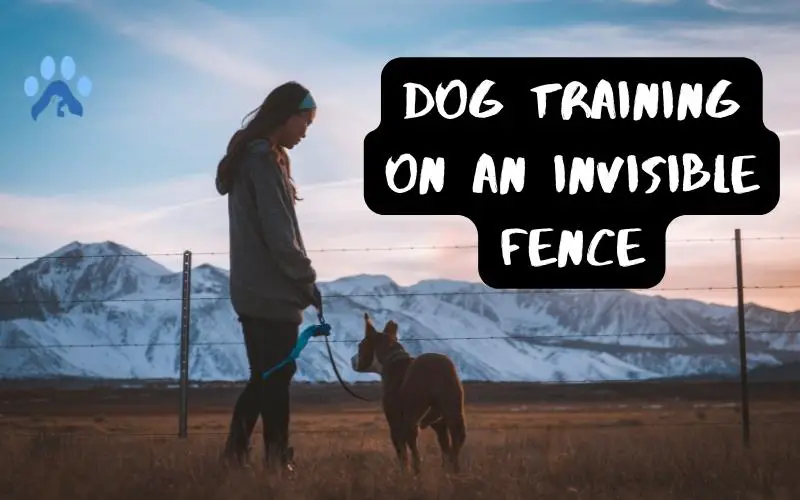It is common to hear news of pet dogs meeting unfortunate accidents, especially in urban areas. It mainly happens because of the owners’ lack of sincerity or control over their pets, which is why the need for dog training sessions are mandatory. And in this case, you could use invisible or wireless dog fences.
But how to train a dog on an invisible fence?
These fences send a radio signal through a wire buried in the ground. When the dog wearing the special collar approaches the boundary of the invisible fence, the collar emits a warning beep.
This way, you can train your pets about their limitations and prevent them from meeting unwanted outcomes.
However, as pet owners, we understand how disturbing it is to shackle our beloved pets with the training process, but it’s necessary for a particular time.
So, without further ado, let’s get started.
The Response to the Signal Method
This method is recommended and preferred by many invisible fence trainers. The steps that are used in this process are discussed below:
1) Send Signals Only
In the beginning, set the radio collar of your invisible electric fence to send signals only. This way, when your dog gets closer or crosses the invisible crossing line, the collar will only send signals to your dog without static shock.
2) Approach the Fence-line
Use the leash and non-metallic collar when taking your dog for a walk. Then, try approaching the electric dog fence line or roaming around the crossing line. It is crucial to follow every invisible fence training process.
3) Correct Your Dog According to the Audio Signals
The collar will send audio signals to your dog when it is around or close to the invisible boundary. Upon hearing the signals correct your dog to move the other way.
After some time, the dog will instinctively try to move with the signals. If he does it accurately, give him treats for positive enforcement.
Then, finally, when the dog familiarises himself with the invisible fence line and moves away from the crossing line upon signals, you can turn on the static correction stimulus. However, don’t set the biggest static shock first; go from the lowest.
4) Train Your Dog with the Signals
Continue taking your dog for walks in the vicinity of the invisible line. If your dog fails to move away with the signals and crosses the invisible fence line, he will get a mild static shock.
Then, test your dog to see if he will cross the line for any distractions. For example, put something your dog likes to play with or another dog past the line to see if he goes beyond the boundary.
5) Turn up the Static Shock
Your dog will now learn that he will get stimulus shock if he goes beyond the invisible fence line. However, if it doesn’t follow the signals or correction stimulus, you can turn up the static shock. Turn up the volume as long as your pet stays within the line and doesn’t get distracted by anything. Keep giving him positive reinforcement when he obeys.
6) Lose the Leash
Lose the leash on your pet now. Still, keep a close inspection to see if he returns upon hearing the signals. Correction stimulus might need to adjust depending on your dog’s response, but eventually, the dog will learn better than to go beyond the boundary.
The Recall and Flags Method
It is another crucial technique of a dog’s training on an invisible electric fence that includes,
1) Teach Your Dog to Respond
Try to teach your “good boy” to respond when you call out to him. For example, put him on a long leash while you call him to come to you.
2) Use Noticeable Flags
Put noticeable flags on a straight line where the invisible boundary is supposed to be. The dog can visualize the fence line in this way.
3) Call Your Dog Whenever He Crosses the Invisible Fence
Let your dog walk around the invisible wireless dog fence boundary. When he crosses the safe zone, the audio signal from the radio receiver collar can be heard.
Whenever you listen to the signal, call your dog back. Give him some dog retreats if your dog reacts positively to your calls and comes to you, leaving the perimeter of the electric fences.
Soon, your dog will learn to respond to the signals and move away from the boundary line upon hearing them. But first, test your dog to see if he will set his foot outside the line for any distractions.
Put a ball he likes to play with or a neighbor’s dog on the other side to test if he ignores the signals and goes beyond the line.
4) Let Your Dog Be Free But Keep an Eye on Him
Allow your dog to roam free without any leash. However, be sure not to leave him unsupervised until you finish training your pup. Before he is allowed to wander off on his own, it will help him become adequately acquainted with the fence’s boundaries.
5) Turn Down All the Flags
Lastly, put down all the flags you had set up at the beginning and level your dog unsupervised so he instinctively knows where the fence line should be. Then, keep monitoring your dog until he responds accurately to the signals.
Fundamental Tips for Dog Fence Training
- Bring lots of treats your pet loves when you begin the training.
- Use a leash and stimulus collar at first. Make sure you don’t use metal collars, as it interferes with the signal from the fence.
- The stimulus collar warns the dog with an audible signal when it is closer to the boundaries. Even if it does cross, the static shock acts as a correction and allows the pet to be safely contained in the zone.
- Avoid crossing the line with the leash, so your pet doesn’t meet any shocks. Too many errors and trials may make the dog confused and afraid and have a negative impact.
Conclusion
As we discussed how to train a dog on an invisible fence, we hope it helped you learn to save a pup’s life from tragic casualties.
However, the training would be most effective if the owner understood the risks and was not clueless beforehand. Good companionship between the dog and its owner is required the most.
Ultimately, you must understand the main goal is to keep your dog safe and do everything with compassion while training your dog.
FAQs
Where to Install an Invisible Dog Fence?
The fenced-in area doesn’t serve any purpose in rural areas where people generally keep dogs within an expansive yard to guard their property. It can be costly too, and a hindrance to their safety.
You can install invisible fences underground or have a transmitter set that allows a certain distance from a central point.
Whichever you choose, make sure you set eye-catching training flags on the ground indicating the boundary set by the devices. Setting appropriate zone with flags helps with the training, and the dog can visualize the boundary.
Why Do People Use Invisible Fences?
1) Giving pup off-leash experience
Dogs are energetic and playful pets. Dog owners usually want their pups to feel the freedom that physical barriers may constrict. With invisible fences on, the dogs get an off-leash experience. Invisible fences overalls make the dog’s standard of living better.
2) Invisible fences are less costly than physical barriers
Especially in rural areas where every other house has large yards, physical building barriers are inefficient as they will cost a ton.
3) Invisible fences may save the dog from possible accidents
In urban areas with plenty of vehicles here and there, dogs cannot roam freely. It is a risky option as accidents are everyday affairs. Dog owners can also face backlash for their dog’s naughty behavior if they are not adequately controlled.
For these reasons, invisible fences are a reliable option for many dog owners. As we have mentioned earlier, however, it also requires simple methods to train them.
What are the Potential Downsides of Training the Dogs for Invisible Fences?
1) Risk of aggression or fear response
In the training process for invisible fences, the owners use static shocks; although mild, they can make the delicate pet go wild. Unfortunately, many inexperienced owners are not fit for this kind of training.
Many owners may not know the “correct” adjustments of correction stimulus that may leave the pet traumatized. As a result, they can often provoke aggressive behavior from the pet.
2) The pup may associate the shocks with something else
A crucial point that many of us overlook is that dogs are less cognitive than humans. So, we must be very sincere when giving our pet shock therapy.
If there’s any tragic event happening when he is getting shocks, the dog may relate the event to the shocks. As a result, it may cause problems later, making the pet more confused and afraid.
3) Often time we don’t know which dogs may be appropriate for this kind of training
Not all pups are the same. It is pretty unpredictable which dogs will face problem with this kind of problem, so the owners should be known about this risk.



